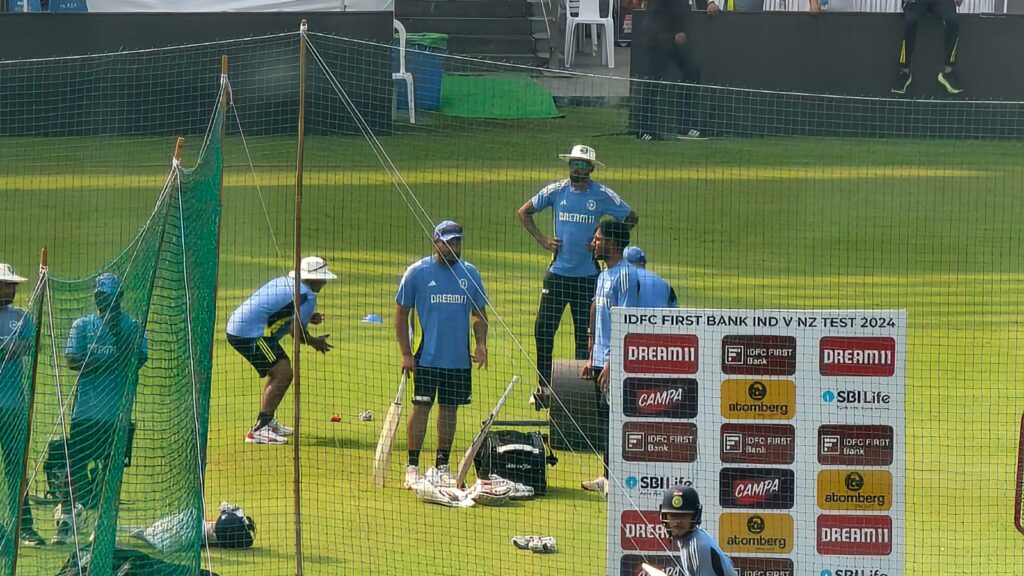
The white lines marking the off and leg stumps were back in the India nets as the Men in Blue sweated it out at the Wankhede Stadium on the eve of the third and final Test against New Zealand. The focus was firmly on the two senior-most batters in the team, Rohit Sharma and Virat Kohli, following their inconsistent run of form in the longest format of the game.
Kohli was the first to walk out to bat in the nets. The primary focus was on the farthest net, where all the main spinners — Ravichandran Ashwin, Axar Patel, Kuldeep Yadav, Washington Sundar, and Ravindra Jadeja — were operating. Kohli took on the spinners, and unlike his match form, looked at ease against them all. By the time Kohli had settled in, other top-order batters like Yashasvi Jaiswal and Shubman Gill also took charge in the adjacent nets, while captain Rohit Sharma kept a close eye from a bench just behind the nets. For Kohli, the focus was more on playing on the back foot as he fine-tuned his cuts and back-foot punches. Occasional sweeps were also observed, but the Indian batting maestro, who has scored 6, 17, 47, 29*, 0, 70, 1, and 17 in the last four Tests, tackled the spinners quite well. While the focus was mostly on settling down with his backfoot game, interestingly, he was also using his feet more with longer strides to punch down the ground in the ‘V’ region, occasionally dancing down the track for good-length deliveries. There were some big hits on display as well, with Kuldeep Yadav and Axar Patel often at the receiving end of Kohli’s lofted strokes.
However, when Kohli switched to another net where Akash Deep and a few young net bowlers were bowling, he was beaten several times. On his first delivery from a youngster, he extended his stride to drive and was comfortably beaten. The next ball, a sharp inswinger from another youngster, also troubled Kohli. Yet, once he settled in, there were some crisp shots that caught the eye.
Red or black? Throw in soil of a few other hues when it comes to preparing a pitch? For India, it’s crucial not to lose sleep over the nature of pitch and just get along with the game instead.@atreyom #INDvNZhttps://t.co/MVF8lyRY4y
— RevSportz Global (@RevSportzGlobal) October 31, 2024
By the time Kohli was done, Rohit was fully padded up and took charge against the pacers for a brief period. Rohit looked focused, leaving more deliveries and defending those in the off-stump channel. There were no flashy shots; Rohit seemed intent on simply trusting his defense, which has been a concern in his Test batting pattern. For Rohit, the scores in the last four Tests have been 6, 5, 23, 8, 2, 52, 0, and 8.
With an army of net bowlers present, this was possibly the last training session for the Indian team before the Mumbai Test, after which they will fly out to Perth for the five-Test series Down Under. Even other batters like Sarfaraz Khan, Rishabh Pant, and Shubman Gill were more focused on defending the ball rather than going for fancy drives or big hits.
Gautam Gambhir, the India head coach, in the pre-match press conference, emphasised the importance of having a solid foundation and good defence for being a successful cricketer across formats.
“To be a successful Test cricketer, look at players like Virat, all the great players who’ve done really well in Test cricket over a long period, they’ve always had a good defence. The foundation of your batting in Test cricket must be defence,” Gambhir explained. “It’s probably due to playing on flat wickets in T20 cricket. But we need to keep working on our defence, we need to keep tightening our game. Because Test cricket is Test cricket.
“And we need to keep getting better. We need to improve our defence. This is crucial, especially on a turning track. Because if you’ve got confidence in your defence, a lot of things can be managed. And that’s something we need to keep improving, keep working on. Sometimes you get so used to muscling the ball that you forget about using soft hands, which was more common 8 or 10 years ago. The foundation is very, very important.”
🚨Is IPL retention deadline day a distraction ahead of 3rd Test? Are we going to see Big 5 for the last time in home Test together?@atreyom and @CricSubhayan discuss. Share your thoughts.@BCCI #INDvNZ #INDvsNZ #IPLRetention #IPLAuction pic.twitter.com/hmaa1TqTLk
— RevSportz Global (@RevSportzGlobal) October 31, 2024



